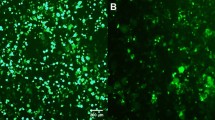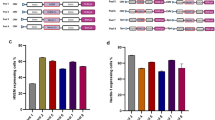Abstract
Transfection of surface adherent cells remain as a standard methodology for lentiviral production for early phase clinical studies and research purposes. Production today is based on transient co-transfection of three or four plasmids, where the viral elements are encoded separately for safety reasons. Assembly of functional lentiviral particles requires all plasmids to be efficiently transfected into each cell, a notable challenge with many currently available methods for transient transfection. We have previously demonstrated the significant improvement of cationic polymer-based transfection in various cell types using a combination of fusogenic lipids and histone deacetylase 6 inhibitor (Enhancers). In this report, we focused on the transfection step and the feasibility of improving lentiviral production using the Enhancers. After optimization of DNA amount and N/P ratio, transfection using seven commercial gene carriers showed comparable maximal efficiency of production with high cell viability. In the presence of Enhancers, the production of functional lentivirus using LPEI was increased by as much as tenfold and outperformed lentiviral production using Lipofectamine 3000. We demonstrate a scalable and optimized workflow where the use of the Enhancers significantly improved the lentiviral particle production in various HEK293 cell lines.
This is a preview of subscription content, access via your institution
Access options
Subscribe to this journal
Receive 12 print issues and online access
$259.00 per year
only $21.58 per issue
Buy this article
- Purchase on Springer Link
- Instant access to full article PDF
Prices may be subject to local taxes which are calculated during checkout








Similar content being viewed by others
References
Vodicka MA. Determinants for lentiviral infection of non-dividing cells. Somatic Cell Mol Genet. 2001;26:35–49.
Lundstrom K. Viral vectors in gene therapy. Diseases. 2018;6:42.
Kaiser AD, Assenmacher M, Schröder B, Meyer M, Orentas R, Bethke U, et al. Towards a commercial process for the manufacture of genetically modified T cells for therapy. Cancer Gene Ther. 2015;22:72.
Levine BL, Miskin J, Wonnacott K, Keir C. Global manufacturing of CAR T cell therapy. Mol Ther Methods Clin Dev. 2017;4:92–101.
Alexandra McCarron MD, Parsons David. Scale-up of lentiviral vectors for gene therapy: advances and challenges. Cell Gene Ther Insights. 2017;3:719–29.
Subklewe M, von Bergwelt-Baildon M, Humpe A. Chimeric antigen receptor T cells: a race to revolutionize cancer therapy. Transfus Med Hemother. 2019;46:15–24.
Stripecke R, Koya RC, Ta HQ, Kasahara N, Levine AM. The use of lentiviral vectors in gene therapy of leukemia: combinatorial gene delivery of immunomodulators into leukemia cells by state-of-the-art vectors. Blood Cells, Mol Dis. 2003;31:28–37.
Jarraya B, Boulet S, Ralph GS, Jan C, Bonvento G, Azzouz M, et al. Dopamine gene therapy for Parkinson’s disease in a nonhuman primate without associated dyskinesia. Science Transl Med. 2009;1:2ra4.
White M, Whittaker R, Gandara C, Stoll EA. A guide to approaching regulatory considerations for lentiviral-mediated gene therapies. Hum Gene Ther Methods. 2017;28:163–76.
Srinivasakumar N. HIV-1 vector systems. Somatic Cell Mol Genet. 2001;26:51–81.
Barde I, Salmon P, Trono D. Production and titration of lentiviral vectors. In: Current protocols in neuroscience. John Wiley & Sons, Ltd.; 2010. Chapter 4:Unit 4.21.
Morita S, Kojima T, Kitamura T. Plat-E: an efficient and stable system for transient packaging of retroviruses. Gene Ther. 2000;7:1063–6.
Clark KR. Recent advances in recombinant adeno-associated virus vector production. Kidney Int. 2002;61 Suppl 1:S9–15.
Zhou H, Liu ZG, Sun ZW, Huang Y, Yu WY. Generation of stable cell lines by site-specific integration of transgenes into engineered Chinese hamster ovary strains using an FLP-FRT system. J Biotechnol. 2010;147:122–9.
Hélio A, Tomás AFR, Alves PM, Coroadinha AS. Lentiviral gene therapy vectors: challenges and future directions. In: Gene therapy. IntechOpen; 2013. https://www.intechopen.com/books/gene-therapy-tools-and-potential-applications/lentiviral-gene-therapy-vectors-challenges-and-future-directions.
Klages N, Zufferey R, Trono D. A stable system for the high-titer production of multiply attenuated lentiviral vectors. Mol Ther. 2000;2:170–6.
Farson D, Witt R, McGuinness R, Dull T, Kelly M, Song J, et al. A new-generation stable inducible packaging cell line for lentiviral vectors. Hum Gene Ther. 2001;12:981–97.
Tang Y, Garson K, Li LI, Vanderhyden BC. Optimization of lentiviral vector production using polyethylenimine-mediated transfection. Oncol Lett. 2015;9:55–62.
Karolewski BA, Watson DJ, Parente MK, Wolfe JH. Comparison of transfection conditions for a lentivirus vector produced in large volumes. Hum Gene Ther. 2003;14:1287–96.
Coleman JE, Huentelman MJ, Kasparov S, Metcalfe BL, Paton JF, Katovich MJ, et al. Efficient large-scale production and concentration of HIV-1-based lentiviral vectors for use in vivo. Physiol Genom. 2003;12:221–8.
Kosaka Y, Kobayashi N, Fukazawa T, Totsugawa T, Maruyama M, Yong C, et al. Lentivirus-based gene delivery in mouse embryonic stem cells. Artif Organs. 2004;28:271–7.
Shin KJ, Wall EA, Zavzavadjian JR, Santat LA, Liu J, Hwang JI, et al. A single lentiviral vector platform for microRNA-based conditional RNA interference and coordinated transgene expression. Proc Natl Acad Sci USA. 2006;103:13759–64.
Witting SR, Li L-H, Jasti A, Allen C, Cornetta K, Brady J, et al. Efficient large volume lentiviral vector production using flow electroporation. Hum Gene Ther. 2012;23:243–9.
Merten O-W, Hebben M, Bovolenta C. Production of lentiviral vectors. Mol Ther Methods Clini Dev. 2016;3:16017.
Kuroda H, Kutner RH, Bazan NG, Reiser J. Simplified lentivirus vector production in protein-free media using polyethylenimine-mediated transfection. J Virol Methods. 2009;157:113–21.
van der Loo JC, Wright JF. Progress and challenges in viral vector manufacturing. Hum Mol Genet. 2016;25:R42–52.
Lee JH, Welsh MJ. Enhancement of calcium phosphate-mediated transfection by inclusion of adenovirus in coprecipitates. Gene Ther. 1999;6:676–82.
Ramamoorth M, Narvekar A. Non viral vectors in gene therapy—an overview. J Clin Diagn Res. 2015;9:GE01–6.
Ho YK, Zhou LH, Tam KC, Too HP. Enhanced non-viral gene delivery by coordinated endosomal release and inhibition of beta-tubulin deactylase. Nucleic Acids Res. 2017;45:e38.
Zhu L, Mahato RI. Lipid and polymeric carrier-mediated nucleic acid delivery. Expert Opin Drug Deliv. 2010;7:1209–26.
Jäger V, Büssow K, Schirrmann T. Transient recombinant protein expression in mammalian cells. In: Al-Rubeai M, editor. Animal cell culture. Cham: Springer International Publishing; 2015. p. 27–64.
Vaughan EE, Dean DA. Intracellular trafficking of plasmids during transfection is mediated by microtubules. Mol Ther. 2006;13:422–8.
Zhou X, Liu Z, Wang H, Liu X, Zhou Z, Tang J, et al. SAHA (vorinostat) facilitates functional polymer-based gene transfection via upregulation of ROS and synergizes with TRAIL gene delivery for cancer therapy. J Drug Target. 2019;27:306–14.
Vectalys. Vectalys’ know how. Vectalys. 2016. http://www.vectalys.com/lentiviral-vectors/vectalys-know-how/.
Geraerts M, Willems S, Baekelandt V, Debyser Z, Gijsbers R. Comparison of lentiviral vector titration methods. BMC Biotechnol. 2006;6:34.
Gandara C, Affleck V, Stoll EA. Manufacture of third-generation lentivirus for preclinical use, with process development considerations for translation to good manufacturing practice. Hum Gene Ther Methods. 2018;29:1–15.
Valkama AJ, Leinonen HM, Lipponen EM, Turkki V, Malinen J, Heikura T, et al. Optimization of lentiviral vector production for scale-up in fixed-bed bioreactor. Gene Ther. 2018;25:39–46.
Rout-Pitt N, McCarron A, McIntyre C, Parsons D, Donnelley M. Large-scale production of lentiviral vectors using multilayer cell factories. J Biol Methods. 2018;5:e90.
Tomás HA, Rodrigues AF, Carrondo MJT, Coroadinha AS. LentiPro26: novel stable cell lines for constitutive lentiviral vector production. Sci Rep. 2018;8:5271.
Zufferey R. Production of lentiviral vectors. Curr Top Microbiol Immunol. 2002;261:107–21.
Segura MM, Garnier A, Durocher Y, Ansorge S, Kamen A. New protocol for lentiviral vector mass production. Methods Mol Biol. 2010;614:39–52.
McCarron A, Donnelley M, McIntyre C, Parsons D. Challenges of up-scaling lentivirus production and processing. J Biotechnol. 2016;240:23–30.
Kolata G. Gene therapy hits a peculiar roadblock: a virus shortage. New York Times; 2017. https://www.nytimes.com/2017/11/27/health/gene-therapy-virus-shortage.html.
Hornstein BD, Roman D, Arévalo-Soliz LM, Engevik MA, Zechiedrich L. Effects of circular DNA length on transfection efficiency by electroporation into HeLa cells. PloS ONE. 2016;11:e0167537–e.
Valkama AJ, Leinonen HM, Lipponen EM, Turkki V, Malinen J, Heikura T, et al. Optimization of lentiviral vector production for scale-up in fixed-bed bioreactor. Gene Ther. 2017;25:39.
Ansorge S, Lanthier S, Transfiguracion J, Durocher Y, Henry O, Kamen A. Development of a scalable process for high-yield lentiviral vector production by transient transfection of HEK293 suspension cultures. J Gene Med. 2009;11:868–76.
Pelascini LP, Janssen JM, Goncalves MA. Histone deacetylase inhibition activates transgene expression from integration-defective lentiviral vectors in dividing and non-dividing cells. Hum Gene Ther. 2013;24:78–96.
Jaalouk DE, Crosato M, Brodt P, Galipeau J. Inhibition of histone deacetylation in 293GPG packaging cell line improves the production of self-inactivating MLV-derived retroviral vectors. Virol J. 2006;3:27. -
Loew R, Selevsek N, Fehse B, von Laer D, Baum C, Fauser A, et al. Simplified generation of high-titer retrovirus producer cells for clinically relevant retroviral vectors by reversible inclusion of a lox-P-flanked marker gene. Mol Ther. 2004;9:738–46.
Marrero-Hernández S, Márquez-Arce D, Cabrera-Rodríguez R, Estévez-Herrera J, Pérez-Yanes S, Barroso-González J, et al. HIV-1 Nef targets HDAC6 to assure viral production and virus. Infection. 2019;10:2437.
Chan LM, Coutelle C, Themis M. A novel human suspension culture packaging cell line for production of high-titre retroviral vectors. Gene Ther. 2001;8:697–703.
Gasmi M, Glynn J, Jin MJ, Jolly DJ, Yee JK, Chen ST. Requirements for efficient production and transduction of human immunodeficiency virus type 1-based vectors. J Virol. 1999;73:1828–34.
Angelo Luis Caron VP-C, Ansorge Sven, Covas DimasTadeu, Kamen Amine, Swiech Kamilla. Production of lentiviral vectors encoding recombinant factor VIII expression in serum-free suspension cultures. Braz Arch Biol Technol. 2015;58:923–8.
Gloger I, Arad G, Panet A. Regulation of Moloney murine leukemia virus replication in chronically infected cells arrested at the G0/G1 phase. J Virol. 1985;54:844–50.
Sena-Esteves M, Tebbets JC, Steffens S, Crombleholme T, Flake AW. Optimized large-scale production of high titer lentivirus vector pseudotypes. J Virol Methods. 2004;122:131–9.
Chen Y, Ott CJ, Townsend K, Subbaiah P, Aiyar A, Miller WM. Cholesterol supplementation during production increases the infectivity of retroviral and lentiviral vectors pseudotyped with the vesicular stomatitis virus glycoprotein (VSV-G). Biochem Eng J. 2009;44:199–207.
Rodrigues A, Alves PM, Coroadinha A. Production of retroviral and lentiviral gene therapy vectors: challenges in the manufacturing of lipid enveloped virus. In: Viral gene therapy. IntechOpen; 2011. https://www.intechopen.com/books/viral-gene-therapy/production-of-retroviral-and-lentiviral-gene-therapy-vectors-challenges-in-the-manufacturing-of-lipi.
Guo W, Lee RJ. Efficient gene delivery using anionic liposome-complexed polyplexes (LPDII). Biosci Rep. 2000;20:419–32.
van de Wetering P, Cherng J-Y, Talsma H, Hennink WE. Relation between transfection efficiency and cytotoxicity of poly(2-(dimethylamino)ethyl methacrylate)/plasmid complexes. J Control Release. 1997;49:59–69.
Huh SH, Do HJ, Lim HY, Kim DK, Choi SJ, Song H, et al. Optimization of 25 kDa linear polyethylenimine for efficient gene delivery. Biologicals. 2007;35:165–71.
Hanawa H, Yamamoto M, Zhao H, Shimada T, Persons DA. Optimized lentiviral vector design improves titer and transgene expression of vectors containing the chicken β-globin locus HS4 insulator element. Mol Ther. 2009;17:667–74.
Segura MM, Mangion M, Gaillet B, Garnier A. New developments in lentiviral vector design, production and purification. Expert Opin Biol Ther. 2013;13:987–1011.
Storck A, Ludtke J, Kopp L, Juckem L. Development and optimization of a high titer recombinant lentivirus system. BioTechniques. 2017;63:136–8.
Gelinas JF, Davies LA, Gill DR, Hyde SC. Assessment of selected media supplements to improve F/HN lentiviral vector production yields. Sci Rep. 2017;7:10198.
Gabrielson NP, Pack DW. Acetylation of polyethylenimine enhances gene delivery via weakened polymer/DNA interactions. Biomacromolecules. 2006;7:2427–35.
Acknowledgements
This study is funded and supported by SMART Innovation Grant, Technology Adoption Programme and the Department of Biochemistry (National University of Singapore), respectively. The authors would like to thank Justin Tan Bing Quan for his contribution in assisting this study by producing the materials and conducting experiments.
Funding
The funders had no role in study design, data collection and analysis, decision to publish, or preparation of the manuscript. This project is supported by Yong Loo Lin School of Medicine, Adhoc funding from the National University Health System (NUHSRO/2019/085) and SMART Innovation Centre (Grant number: ING-000144 BIO).
Author information
Authors and Affiliations
Corresponding author
Ethics declarations
Conflict of interest
The authors declare that they have no conflict of interest.
Additional information
Publisher’s note Springer Nature remains neutral with regard to jurisdictional claims in published maps and institutional affiliations.
Rights and permissions
About this article
Cite this article
Ho, Y.K., Too, H.P. Development of a laboratory scalable process for enhancing lentivirus production by transient transfection of HEK293 adherent cultures. Gene Ther 27, 482–494 (2020). https://doi.org/10.1038/s41434-020-0152-x
Received:
Revised:
Accepted:
Published:
Issue Date:
DOI: https://doi.org/10.1038/s41434-020-0152-x



